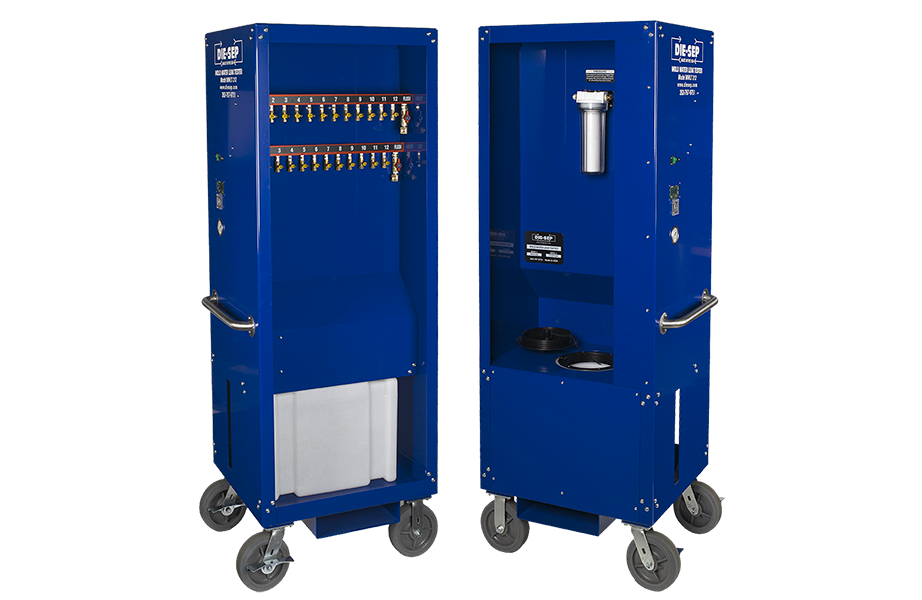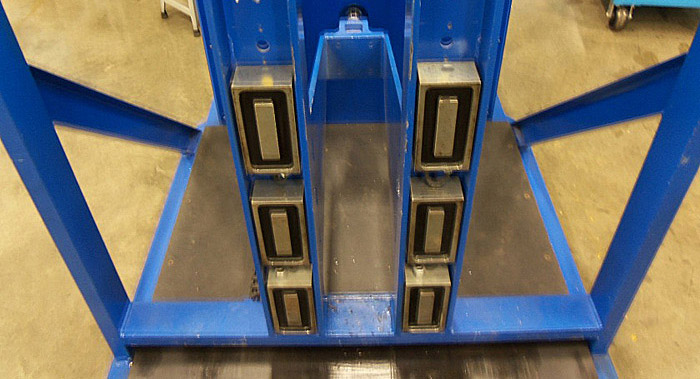Functions
Die-Sep Product Lineup
Mold (mould) splitting – opening the mold
Separating molds is now simple. Using its tool room overhead crane or fork lift, the mold is set into the bay of the Die-Sep with the parting line in a vertical position. With the mold sitting in the bay, the operator pushes the movable platen lever, thus moving the platen towards the mold and continues pushing the lever and platen forward until the mold is touching the stationary/tipping platen. As the mold is now touching both platens, it is ready to be opened. But before doing so, remove or detach the strap of the mold from the two halves and attach the safety chain from the top of each platen to an eye bolt in the top of each mold half. This will add additional safety in the event of a shop electrical power interruption. It can now be opened.
To open the mold, the operator flips the magnet controller switches for both platens, thus, turning on the magnets. Then, with a simple pull of the same lever used to push the movable platen the operator pulls the lever. The magnets have now mounted the mold halves to each platen and, hydraulically, it will be opened to daylight in less than 30 seconds.
Tipping molds and mold halves
After the mold has been opened and has reached daylight, the point where the leader pins have cleared the bushings of the mold’s other half, the operator must continued to open the mold halves far enough so that the bottom of the mold half being tipped will not strike the other half of the mold or the mold’s leader pins.
At this point, the operator then pushes the tipper lever and holds it until the mold half being tipped reaches either a complete horizontal position or is at an angle that the technician desires for working on the mold half. To tip the mold half back down, the reverse occurs. The operator pulls the lever and the mold half is lowered.
Closing molds
While closing the mold is basically the reverse of opening the mold, there is one, slight variation. The magnets are turned off immediately before the mold halves are closed.
The technician will return the mold half being worked on to the platen of the tipper. This occurs with the parting line and tipper in a horizontal position. The technician approximates the location of the mold half to the spot where the leader pins and bushings appear to be in line with one another, even though they are usually slightly out-of-line. The tech reconnects the safety chain to the mold and platen. At this point the mold is ready to be lowered.
The operator then turns on the magnets for the tipper and pulls the tipper lever. Once the mold has been returned to a position with the parting line in a vertical position, the tech pushes the movable platen lever moving it toward the stationary/tipping platen. The operator then visually inspects the leader pins and bushings to see that they are generally in line with one another. Before the leader pins enter the bushings of the other mold half, even though the leader pins and bushings might be out-of-line but close enough for the leader pins to enter the bushings, the operator then turns off the magnets of both platens. Then, when again pushing the movable platen lever, the mold halves will close completely, without jamming and will adjust for any alignment issue.

Servicing, cleaning and repairing molds
The original design of the Die-Sep was to simply open and close molds. But, it is truly much more than that today. It is used as a work station.
Once the mold has been opened to the point there the amount of daylight is 24″ – 36″, the tech will do a “lock out-tag out” (turning off the machine and locking its On/Off switch). Then, the tech will begin cleaning and repairing the mold right in the bay of the Die-Sep.
Is it a light, vertical spotting press? Some tool room technicians think so. They use it for bluing by tapping the lever of the movable platen.

The Magic of Magnets
Each of the two platens of the Die-Sep include a set of electro magnets that, when activated mount the mold halves to each platen. As platens are increased in size to handle taller molds, magnets will be added to the platens. Because a loss of shop power will cause the magnets to deactivate, the tipper platen is equipped with a safety chain for securing the mold or mold half in the event of such a power interruption. Additionally, several customers have preferred to have their Die-Sep machines built with permanent electro magnets, thus virtually eliminating this safety concern.
